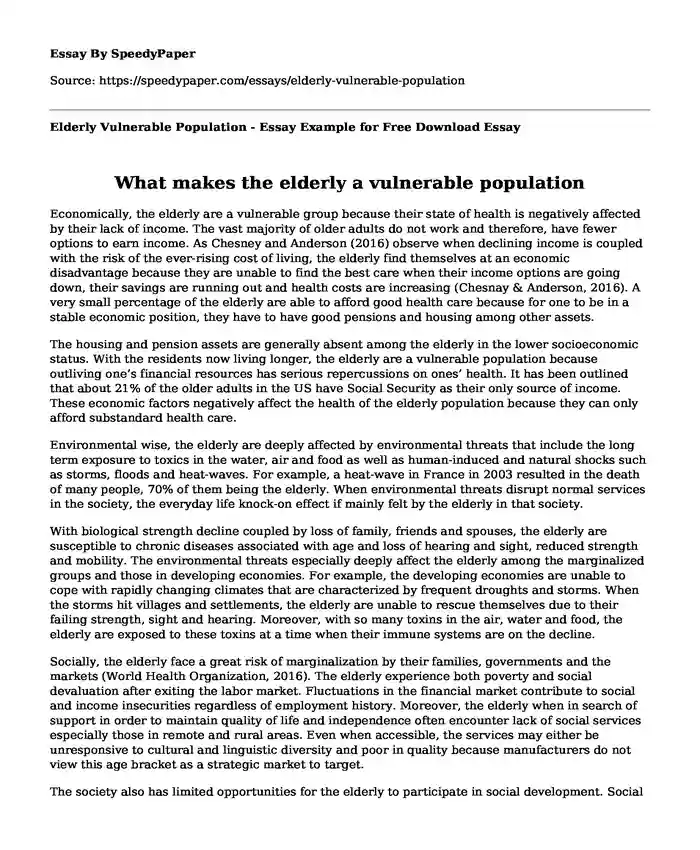
| Type of paper: | Essay |
| Categories: | Health and Social Care Society |
| Pages: | 3 |
| Wordcount: | 703 words |
What makes the elderly a vulnerable population
Economically, the elderly are a vulnerable group because their state of health is negatively affected by their lack of income. The vast majority of older adults do not work and therefore, have fewer options to earn income. As Chesney and Anderson (2016) observe when declining income is coupled with the risk of the ever-rising cost of living, the elderly find themselves at an economic disadvantage because they are unable to find the best care when their income options are going down, their savings are running out and health costs are increasing (Chesnay & Anderson, 2016). A very small percentage of the elderly are able to afford good health care because for one to be in a stable economic position, they have to have good pensions and housing among other assets.
The housing and pension assets are generally absent among the elderly in the lower socioeconomic status. With the residents now living longer, the elderly are a vulnerable population because outliving one’s financial resources has serious repercussions on ones’ health. It has been outlined that about 21% of the older adults in the US have Social Security as their only source of income. These economic factors negatively affect the health of the elderly population because they can only afford substandard health care.
Environmental wise, the elderly are deeply affected by environmental threats that include the long term exposure to toxics in the water, air and food as well as human-induced and natural shocks such as storms, floods and heat-waves. For example, a heat-wave in France in 2003 resulted in the death of many people, 70% of them being the elderly. When environmental threats disrupt normal services in the society, the everyday life knock-on effect if mainly felt by the elderly in that society.
With biological strength decline coupled by loss of family, friends and spouses, the elderly are susceptible to chronic diseases associated with age and loss of hearing and sight, reduced strength and mobility. The environmental threats especially deeply affect the elderly among the marginalized groups and those in developing economies. For example, the developing economies are unable to cope with rapidly changing climates that are characterized by frequent droughts and storms. When the storms hit villages and settlements, the elderly are unable to rescue themselves due to their failing strength, sight and hearing. Moreover, with so many toxins in the air, water and food, the elderly are exposed to these toxins at a time when their immune systems are on the decline.
Socially, the elderly face a great risk of marginalization by their families, governments and the markets (World Health Organization, 2016). The elderly experience both poverty and social devaluation after exiting the labor market. Fluctuations in the financial market contribute to social and income insecurities regardless of employment history. Moreover, the elderly when in search of support in order to maintain quality of life and independence often encounter lack of social services especially those in remote and rural areas. Even when accessible, the services may either be unresponsive to cultural and linguistic diversity and poor in quality because manufacturers do not view this age bracket as a strategic market to target.
The society also has limited opportunities for the elderly to participate in social development. Social development enhances the wellbeing of the elderly because it gives them an opportunity to feel useful, valuable and wanted. The need to belong is especially strong after the loss of friends, family and spouses. With many of the elderly now living alone in homes for the elderly, they are denied the opportunity of social participation and this has been found to rapidly reduce their lifespan. In some cases, the elderly in the homes have argued that their families saw them of no use and therefore sent them into the homes for the elderly for them to die. These thoughts weigh on them heavily and in the long term it affects their development.
References
Chesnay, M. D., & Anderson, B. A. (2016). Caring for the Vulnerable (4th ed.). Sudbury: Jones and Bartlett.
World Health Organization. (2016). Addressing poverty in TB control: Options for national TB control Programmes. Retrieved August 31, 2016, from http://www.who.int/tb/areas-of-work/population-groups/poverty/en/
Cite this page
Elderly Vulnerable Population - Essay Example for Free Download. (2017, Oct 02). Retrieved from https://speedypaper.net/essays/elderly-vulnerable-population
Request Removal
If you are the original author of this essay and no longer wish to have it published on the SpeedyPaper website, please click below to request its removal:
- The Ruining Psychology Essay Example
- Free Essay on Abano Dental's Marketing Mix
- Free Essay Sample on PharmaSim Company
- Essay Example on Ischemic Stroke Case Study
- Free Essay on Research Question and Design
- The Free Essay About Findings and Recommendations for Skrillics
- Essay Example. Rights and Responsibilities of Citizens
Popular categories




